Last Updated on April 23, 2023
Labrador Retrievers (Labs) are easy to train, gentle companions that love everyone – basically the whole package!
These low maintenance dogs are perfect for any family. They are sturdy enough for hunting and gentle enough to trust with kids.

Is the Lab right for you? Find out all there is to know about the iconic family pet in this guide. Get all the pros and cons of this friendly and exuberant breed.
Quick Navigation
- 1 The Labrador Retriever at a Glance
- 2 Labrador Retriever History: From Hunters to Pets
- 3 What’s the Difference Between American and English Labradors?
- 4 The Huggable Labrador Comes in Three Colors
- 5 Is a Labrador a Good Dog?
- 6 Keeping up with your Labrador Means Getting off that Couch
- 7 What Health Problems Do Labradors Have?
- 8 How to Choose a Labrador Puppy?
- 9 Interesting Facts or Highlights about Labrador Retrievers
- 10 Who Should Get a Labrador?
- 11 Further reading: Labrador Retriever Mixes
- 12 Reference
The Labrador Retriever at a Glance
We’ve put together a table below to give you a quick overview of the Labrador Retriever.
| Breed Summary | Labrador Retriever Quick Facts |
| Group | Sporting Group |
| Breed Purpose | Hunting Dog |
| Breed Size | Medium to Large |
| Height | 21.5 to 24.5 inches (55 to 62 cm) |
| Weight | 55 to 80 pounds (25 to 36 kg) |
| Coat Type | Short, Straight, Dense, Double coat |
| Shedding | Heavy |
| Most Popular Coat Colors | Yellow, Black, Chocolate |
| Lifespan | 10 to 12 years |
| Temperament | Intelligent, Outgoing |
| Energy | High |
| Exercise Needs | 1 hour per day |
| Average Price | $800 to $1,500 |
Labrador Retriever History: From Hunters to Pets
These gundogs originated from Newfoundland but they are called Labradors. Why? Since Labrador is just next to Newfoundland, some believe that there was a mix-up and the name stuck.
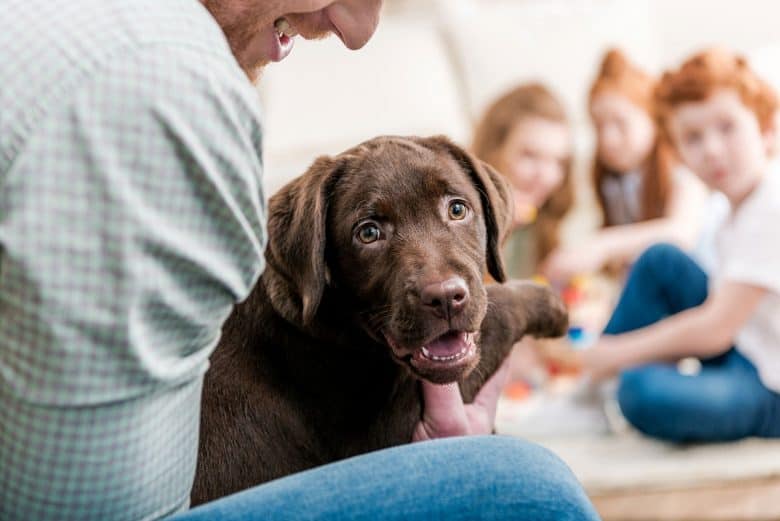
Others believe that their name is derivative of the Spanish word for “labourer” – a tribute to their hardworking nature. Another theory is that they were named for the Labrador sea.
Regardless, they have become a household name in America since 1991. One even made its way into the White House in 1997.
These dogs are descended from the Lesser Newfoundland or St. John’s water dog, much like their Golden Retriever cousins.
They have webbed feet, making them immensely powerful swimmers, with a penchant for retrieving.
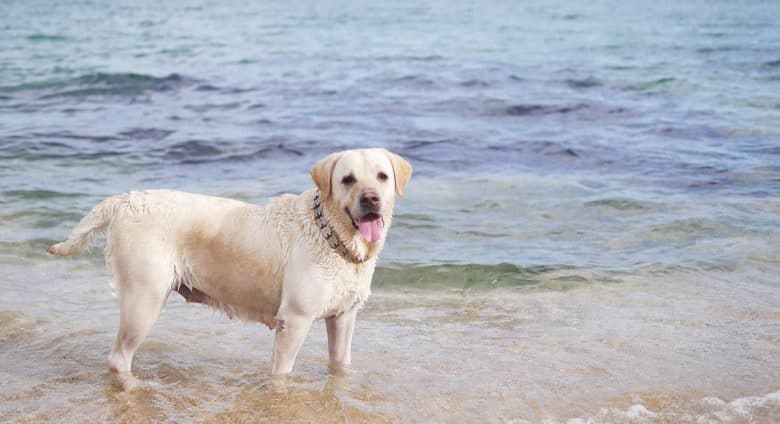
Well-loved by fishermen, they would jump into the freezing ocean and help fishermen drag their nets in. They sometimes even catch escaping fish and ferry messages from one boat to another.
This beloved breed almost went extinct back in the 1880s due to a UK law that prohibits families from having more than one dog. They also imposed heavy taxes on female dogs, which led to them being culled.
The breed was saved by the Malmesbury family and later imported into America around the 1920s – 1930s. This marked the divergence of American and English Labradors.
What’s the Difference Between American and English Labradors?
You’ll mostly find English Labradors in the show ring and Americans working in the field.
The American Labs were selectively bred to work, so they are noticeably much more active than their English counterparts. Think athletes and Olympians. American Labs being the Olympians.
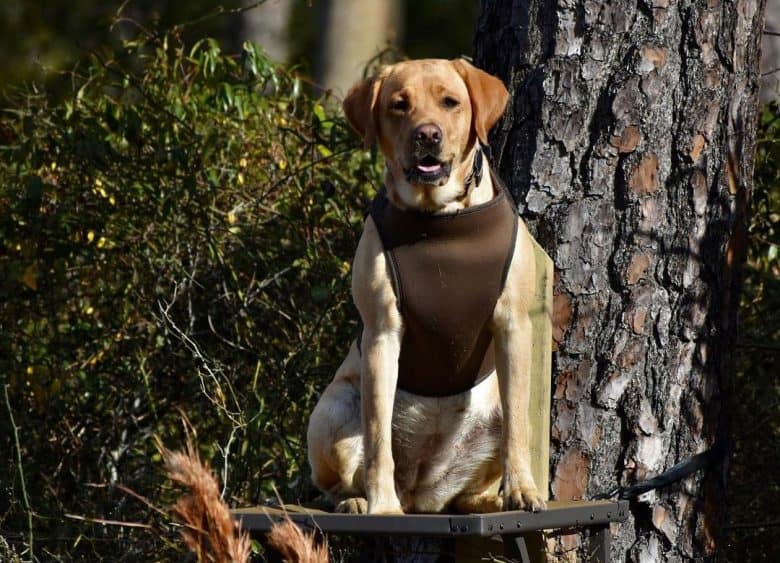
If you’re a first-time owner, you might prefer the less demanding English. But if you want a dog with plenty of energy to spare, the American will make a better choice.
Appearance-wise, there are a few slight differences. The English are shorter and stockier whereas the Americans are slender.

This means that you’ll find a broader head on the English, as well as a more heavy set build. The American has a longer muzzle. They also have a thinner tail, coat, and neck.
The American Lab can grow up to 24.5 inches, but the English often caps at 22.5 inches
Now, just because it looks like an American Lab doesn’t make it one. There are always variations within a breed and they don’t always conform 100%.
The only person who can tell you what type of Lab you have is your breeder.
Read more: English Lab vs American Lab
The Huggable Labrador Comes in Three Colors
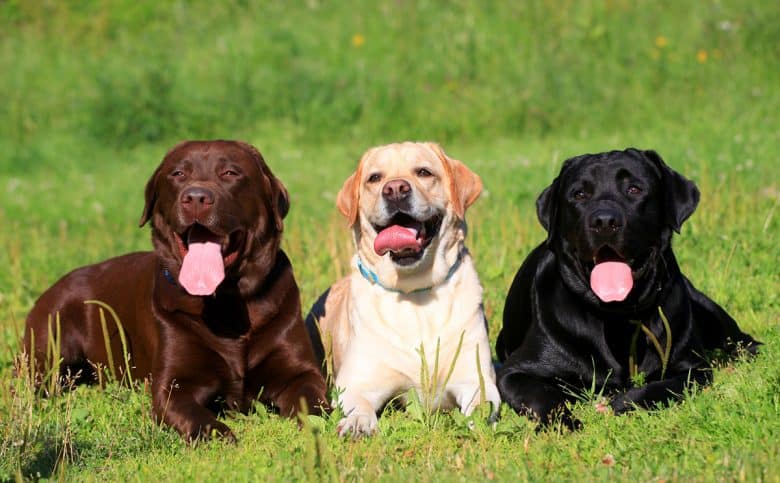
There are three official Labrador colors but Labs can come in varying shades of Yellow, Black, and Chocolate.
Yellow Lab is often associated with guide dogs or laziness. Chocolate Labs are thought to be hyperactive and made for the show ring. Black Labs are the best for hunting.
There is simply no basis for these stereotypes and their color doesn’t affect their temperament.
In recent years, some breeders have begun marketing some colors as rare to make more money off them.
Silver Labs, Lilac Labs, or even White Labs do not conform to the AKC standard and should not be bred specifically for their color.
The breed standard describes the Lab to have yellow coloring which “may range in color from fox-red to light cream, with variations in shading on the ears, back, and underparts of the dog.”
Don’t miss: The most intriguing Labrador Retriever colors of all time
Can Labs be fluffy?
While their dense, short, and tough coats are a breed standard, it is possible for a purebred Labrador to have long hair. This is caused by a hidden recessive gene.
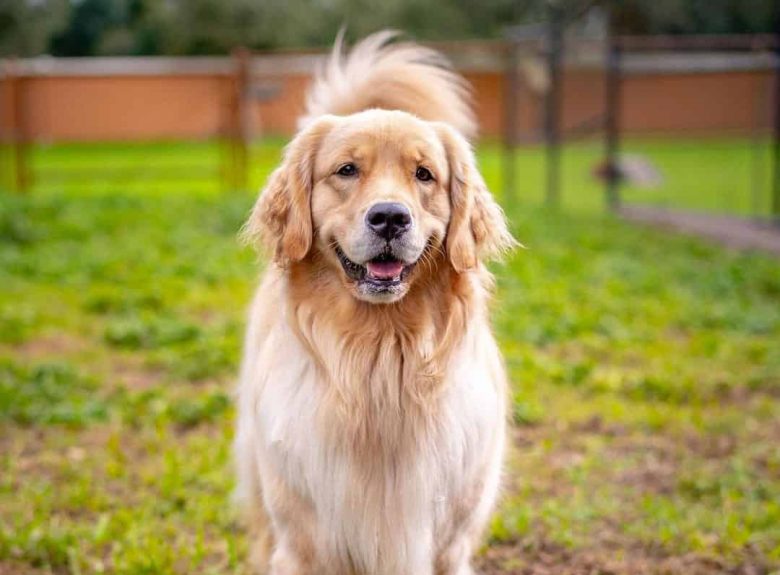
Two dogs that carry this will produce a litter with ¼ exhibiting long hair. As you can see, they look almost identical to the Golden Retriever.
Unfortunately, long-haired Labradors are a fault and will not be able to compete in the show ring.
All Labradors, regardless of coat length, have floppy ears and a sturdy build. These muscular dogs are squarish with a boxy face. They also have a signature “otter tail” which acts as a rudder while swimming.
How big is a full-grown Labrador?
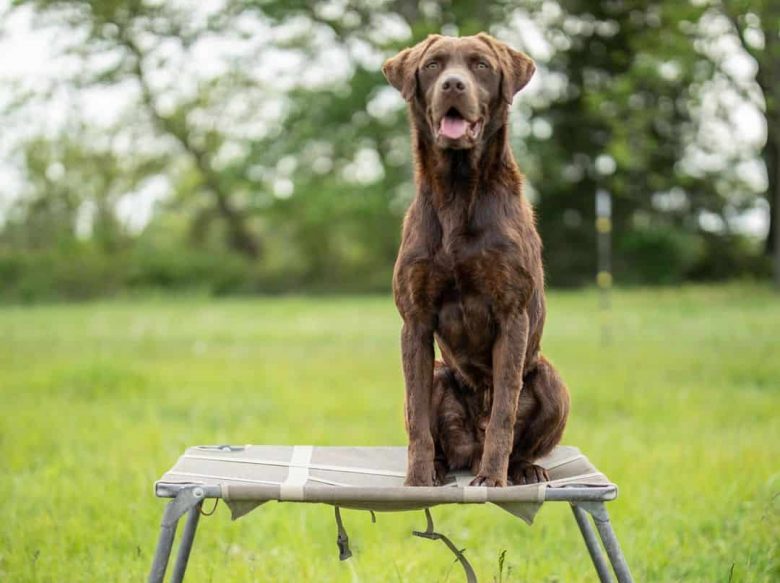
Full-grown male Labradors can be anywhere from 65 to 80 pounds (29 to 36 kg). Depending on whether they are an American or English Labrador, they can range around 22.5 to 24.5 inches (57 to 62 cm).
Female Labs are slightly smaller than males and are commonly 55 to 70 pounds (25 to 32 kg) and 21.5 to 23.5 inches (55 to 60 cm).
Your Labrador should reach its adult height around 6 to 12 months, but they won’t reach their adult weight till they are 2 years old.
Also Read: Lab Growth Chart: When Do Labs Stop Growing?
Is a Labrador a Good Dog?
Labradors are often used as service dogs. You can find them as guide dogs for the blind, in the police force, at the hospital, even at the pool!
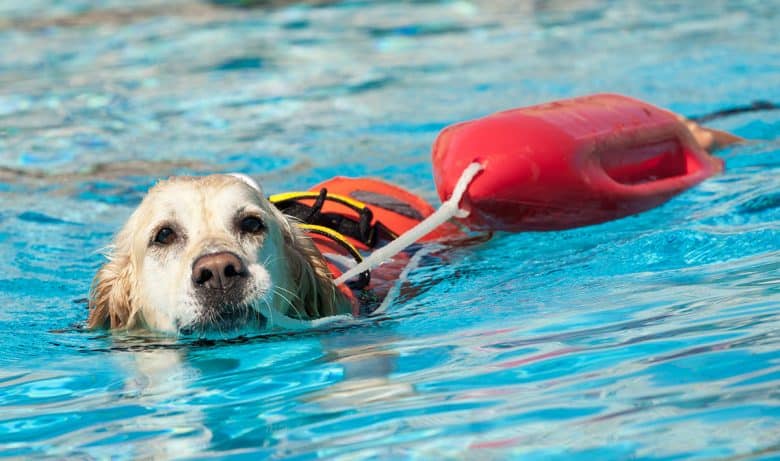
Because they are a working breed, they have the needs of a high-energy dog. You will find that they are quite boisterous as puppies.
Some new owners don’t understand that training plays a huge part in a Lab’s behavior. They often expect their Lab to be a perfect little angel from day one.
But the truth is, only a well-trained Labrador will live up to the breed’s standard.
Labs under the age of four can be quite overwhelming and a bit of a troublemaker, especially if they haven’t been given the stimulation and training they need.
For an idea of how destructive they can get, the movie ‘Marley and Me’ offers a good representation.
How much exercise does a Labrador need?
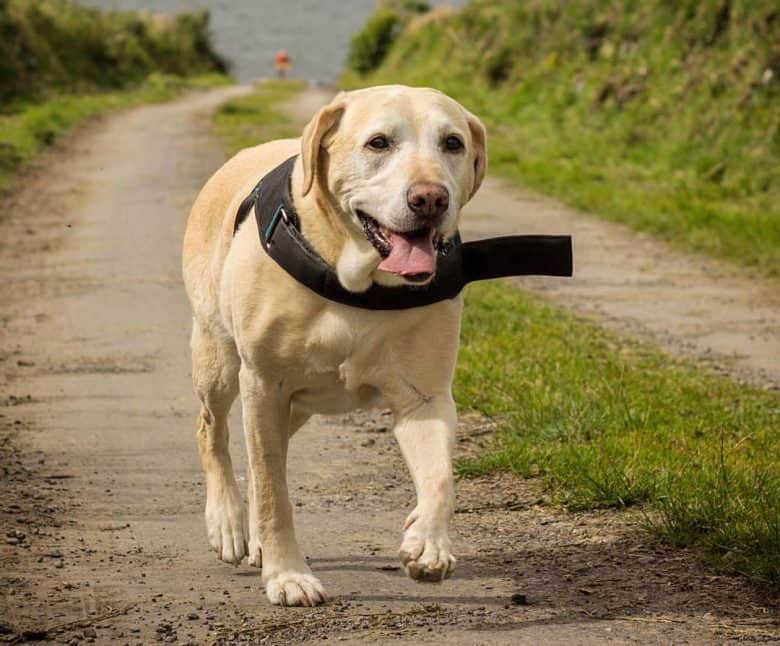
Exercise also plays a part in keeping your dog happy. When you put in the time and effort training and exercising her, a Lab’ll be the best dog you’ll ever have.
But, a word of warning, if you don’t deplete her energy, you’ll find yourself turning into a repairman. She’ll bark, chew, dig, and entertain herself if she doesn’t get the stimulation she needs.
This destructive behavior will go away with proper training and attention.
Labradors can be noisy and bark at strangers, but don’t count on them being great guard dogs.
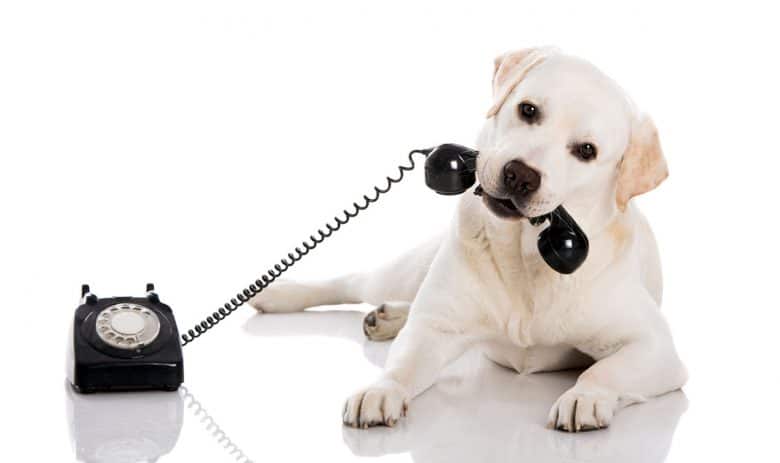
They also tend to be mouthy and love to carry things around in their mouths. Don’t expect to train this instinct out of the Lab, they were bred to retrieve, after all.
You can use this to your advantage and train her to fetch your groceries or daily paper.
Labs are happy to share their home with kids and other pets

Labs are generally very tolerant, especially if they were raised with children. But never leave a young child with a dog, no matter how well behaved she is.
If you have small kids in the house, make sure they know how to behave around a dog. Teach them how to properly approach and handle a dog.
Biting and ear or tail pulling is something that you will have to watch for.
They might be naturally disposed to have a calm temperament, but poor socialization and incomplete training can force them to become aggressive or fearful.
These dogs are seldom aggressive but this doesn’t mean they cannot be.
Look at Holly’s obsession with food and how she attacked world-famous dog trainer, Caesar Milan. A properly socialized dog Lab will accept cats, other dogs, and small animals.
Do Labradors have separation anxiety?
Labradors have a reputation for developing separation anxiety. This disorder can be managed through training, but you generally don’t want to leave your dog alone for extended periods of time.

As a puppy, you’ll need to keep an eye on her to prevent any unwanted habits from forming. They are voracious eaters and eat anything, from cables to socks.
There have been instances of Barbie dolls and razor blades surgically removed from their stomachs.
Crate training can help keep her out of trouble until she learns her manners, but Labradors are not backyard dogs. They absolutely love being around people.
The reason they can thrive in an apartment is that they can be close to other people at all times.
If you do live in an apartment, you need to make sure you meet all of her exercise and energy requirements. If you are absent from home a lot, you might want to get a Basset Hound or Chihuahua instead.
Keeping up with your Labrador Means Getting off that Couch
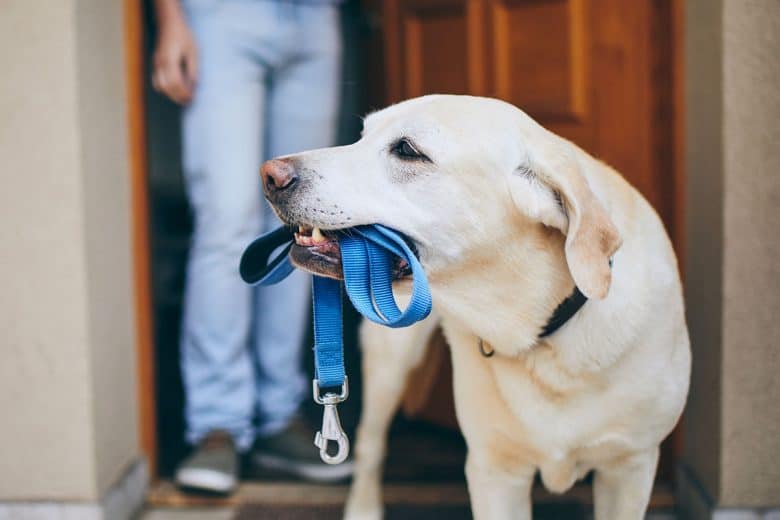
The adult Lab will need a 60 minute romp daily to stay happy and healthy. Once they are properly exercised, they will be more than happy to lay with you on the couch.
You can channel their eagerness to work with training, obedience classes, swimming, or agility.
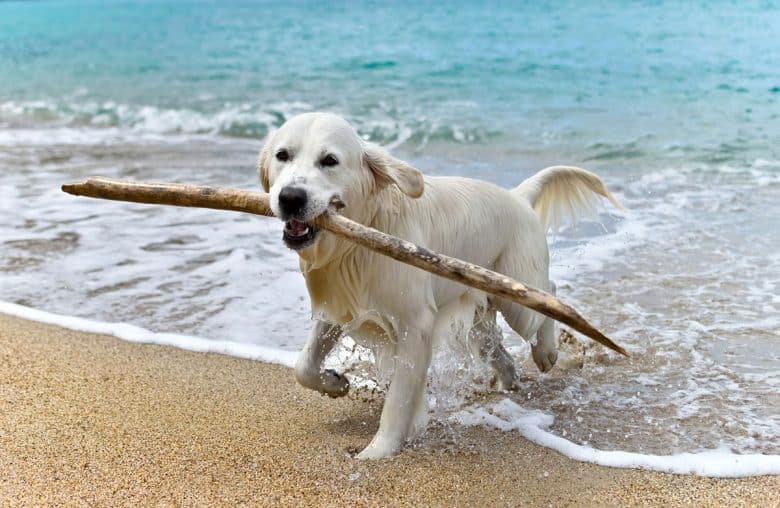
As a puppy, your Labbie will be an inquisitive ball of energy. A few minutes here and there is more than enough to keep your little puppy engaged.
You should control their playtime because too much exercise might cause joint problems or exhaustion. Try to keep them on softer surfaces, too.
Even though Labs aren’t natural escape artists, they might find a way to dig their way out of the yard if something exciting catches their eye. They are single-minded that way.
This laser-like focus will come in handy when you’re training them.
Training a Labrador is a dream because they are eager to please. These obedient dogs want to listen to you, so there’s no need for a firm hand.
Positive training reinforces good habits and it’s the most gentle and humane way to train a dog.
Disciplining your dog with violence is never the answer. You might train her to fear you and cause problems in training.
Labradors are super low maintenance
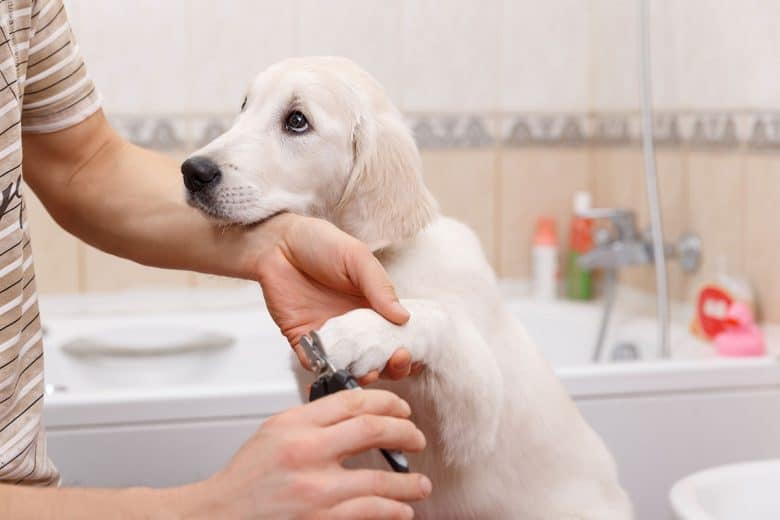
Labs don’t need any fancy grooming and are super easy to care for. This is the biggest distinction between Labs and Goldens or the popular Goldador mix.
You only have to brush them once a week to keep her coat free from dead hair. A sturdy slicker brush ought to do the trick.
Now, don’t let their short coat fool you. They are not hypoallergenic. In fact, they have two dense coats. The undercoat sheds twice a year and you probably want to brush her daily when she’s molting.
Take a look at how much fur to expect during shedding season:
Their teeth should be brushed twice a week. Dental bones work wonders because it can keep her busy too.
Ear infections are a common ailment in water-loving, floppy-eared dogs like the Labrador. You should clean them with a cotton ball after every bath, swim, or whenever she gets wet.
Only the outer ear needs to be cleaned. There’s no need to stick an earbud into her ear canal – this can injure her!
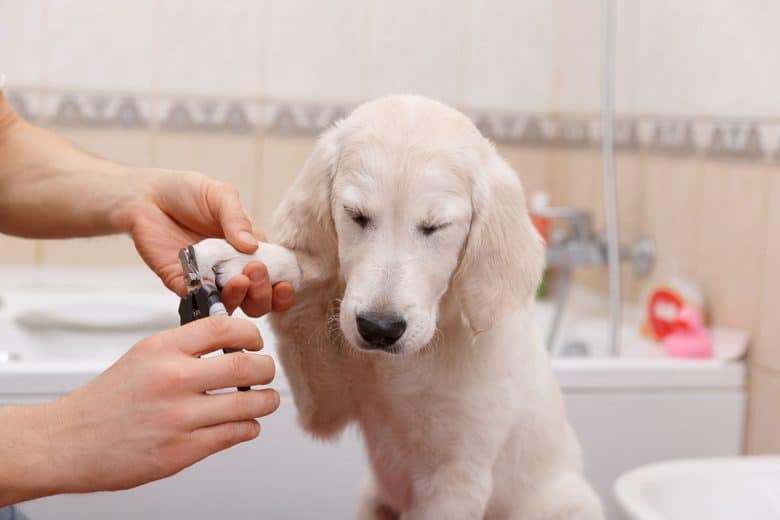
If you hear her nails clicking on the floor, they are too long and need a trim. To keep them in check, snip them every one or two weeks.
Handle your dog often, especially when young. Touch their paws and mouths, get them accustomed to being touched all over. This will help make veterinarian visits and grooming a breeze.
Your Lab needs specially formulated dog food to grow well
The dietary requirements for each dog is different. It depends on their age, their activity level, and other health considerations.
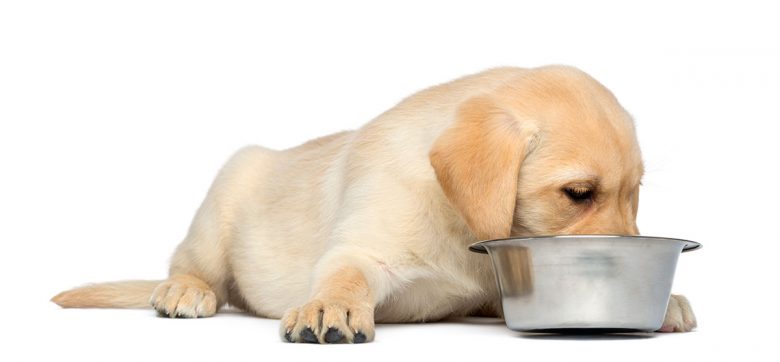
Large breed pups will need low-calorie, high-quality kibble to keep their growth slow and steady. This will prevent bone disorders from developing.
They grow the quickest between four and seven months and special care should be given at that time.
As an adult, you want to give your dog 2.5 to 3 cups a day. It’s best to create a schedule and let her eat two meals a day at the same time and place.
Free-feeding is not encouraged because you might overfeed your Lab. Plus, it will not give her the routine she needs.
What Health Problems Do Labradors Have?
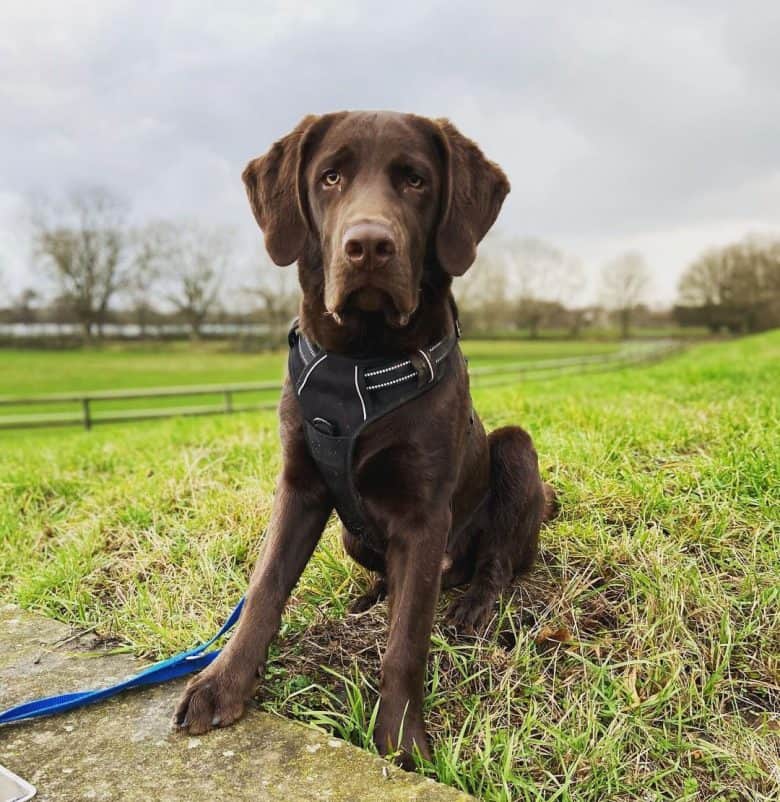
The Lab often lives around 10 to 12 years. There have been instances of Labs living up to 14 years old. The oldest Lab ever recorded lived up to 27 years old. Read our guide about Labrador Retriever Lifespan to learn more about how can you make your Lab live longer.
As with all pedigrees, they are genetically prone to a few disorders. Obesity is one of the most common silent killers for Labs as it can cause many problems and decrease their lifespan. While it might be tempting, don’t overload on the treats.
Being overweight can also aggravate joint problems, such as hip or elbow dysplasia. This disorder can be inherited so make sure to screen your puppy’s parents.
You also want to wait till she’s 2 years and above before you start any intense exercises. Hip and elbow dysplasia can also be controlled with diet.
When it comes to food, Labradors can sometimes eat too quickly This is a problem because stomach twist or bloat often happens to dogs with deep and narrow chests.
Invest in a slow feeder to prevent this from happening.
Portosystemic shunt (PSS) can cause seizures or stunted growth. Another liver-related disorder is called hepatitis. In both cases, early detection through blood paneling is crucial in order to treat it.
Hemolytic Anemia and Thrombocytopenia occur when the immune system attacks the dog’s own red blood cells. Labs with this disorder might have a blood clotting problem.
Labs are also susceptible to Wobbler disease. It manifests as a wobbling gait. This happens when the vertebrae in the neck shrink and pinch a nerve.
Your vet can rectify this with a neck brace, surgery, rehabilitation, or medication, depending on the severity.
Another problem that can cause Labs to walk funny is Myopathy. This is a muscle disorder that usually develops between three to seven months old.
Dogs with Myopathy should not be overexerted and are unsuitable as a hunting companion.
Other problems that Labs might face are Diabetes, which you will need to treat with insulin injections.

Atopy can also develop due to allergies but changing their kibble or giving them medication can fix the problem.
Eye problems are quite common in Labradors. Cataracts, Progressive Retinal Atrophy, all of which could cause blindness.
Check their eyes regularly for anything out of the ordinary. Most of them are inherited from their parents.
Another inheritable disease is epilepsy. It often starts between six months to three years of age. Epileptic dogs will need to be medicated for life.
Lymphoma and Hemangiosarcoma also affect Labs more frequently than other breeds. These tumors usually develop in old age.
They are detectable through blood tests and senior wellness testings or through ultrasounds.
Heart disease is another common problem with Labradors. They are also prone to Exercise Induced Collapse (EIC).
Cushing’s Disease or Hyperadrenocorticism causes your dog to produce too much steroid hormone. This will result in a potbelly, hair loss, and thin skin. The good news? It’s easily treatable.
How to Choose a Labrador Puppy?
Choosing a puppy is more than just picking out the one you think looks the cutest. A reputable breeder will be able to place the right puppy in suitable homes.
You should be able to tell your breeder what kind of lifestyle you lead and how you expect a dog will fit in.

Labs usually have litters of 6 – 8 puppies, and there can be all three colours in a litter. Watching how they interact with their littermates will give you an idea of how they will behave.
Their parents can also help build your expectations because the apple doesn’t fall far from the tree.
For $800 to $1,500, you should expect your Lab to be raised in a clean and loving environment.
They might come with papers, but the parents should most definitely have a clean bill of health.
While you should not be paying extra for color, you may tell the breeder if you have a color preference. Read our article about Labrador Retriever Price to learn more about the factors that affect the cost of Lab puppies.
Puppies should stay with their mom until they are at least 8 weeks old. This gives them a chance to learn some manners from their littermates and mother.
Breeders will also evaluate their personalities and determine which new owner it’s most suited for.
At 8 weeks, she’ll also be mature enough to be housetrained. Any younger and she will not have full control over her bladder.
Read more: Is there a Mini Labrador?
Labrador Retriever Breeders
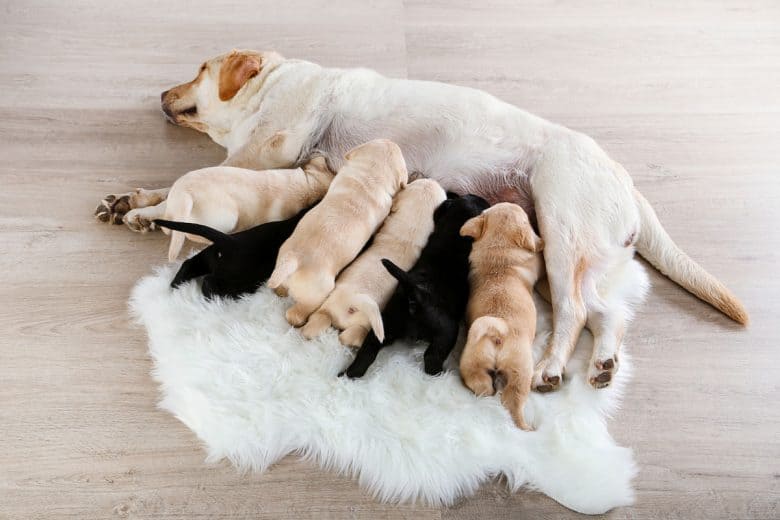
How do you tell whether a breeder is reputable or not? Well, purchasing from a trustworthy breeder is seldom convenient.
They want to make sure their puppies are going to the best homes. This means that they will vet you and make sure you will be a good owner.
You most likely have to sign a contract in regards to the care you will offer your new puppy.
Most of the time, responsible breeders will take the puppy back at any time or age, no questions asked. This does not mean you will be getting a refund, it just means your dog will always have a home to go back to.
Be prepared to answer as many questions as you ask them. If they seem impatient or unwilling to entertain you, go to someone who is more than happy to answer every single question you have.
Finding a good breeder will take time, but it will be worth it in the end when you have a well-adjusted pup to bring home.
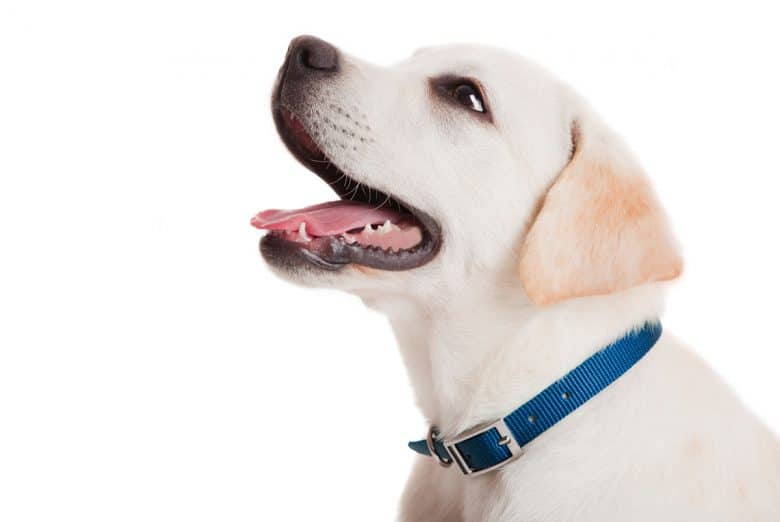
You can go through the directory of breeders at National Labrador Retriever Club, Inc. or choose one from the following:
- Duckhill Kennels (Somerville, TN)
- Wildrose Kennels (Oxford, MS)
- Bayside Labs (Three Forks, MT)
Labrador Rescue Sites
Thanks to their popularity, too many people think that Labradors are naturally obedient dogs. When they find out that’s not the case, they are left at shelters.
This is a shame because most Labs mellow out after their 3rd birthday. Adopting an older dog means they’ll be calmer.
Furthermore, you will know what behavioral problems they might have and prepare for dealing with them.
The shelter will be able to tell you about their personalities and can help you find the dog best suited for you:
- Lab Rescue LRCP (Annandale, VA)
- Labrador Retriever Rescue of Florida (Pompano Beach, FL)
- Golden Gate Labrador Retriever Rescue (San Francisco Bay Area, CA)
Interesting Facts or Highlights about Labrador Retrievers
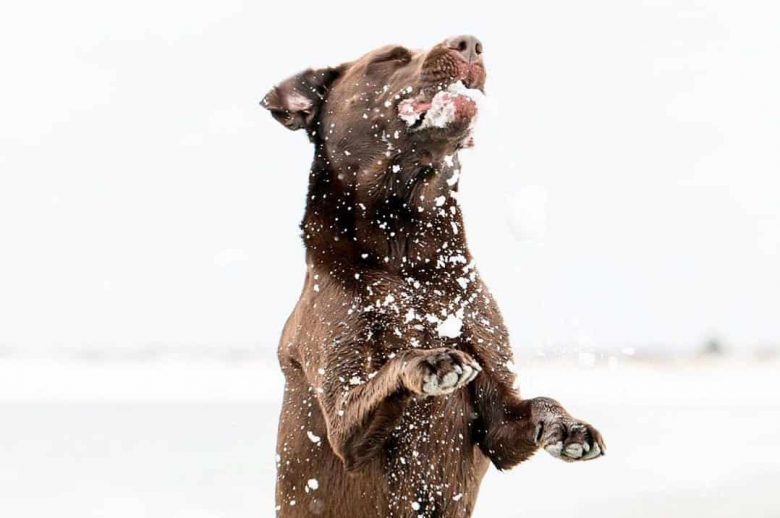
The original Labrador gradually died out in Newfoundland on account of a heavy dog tax which, with the English quarantine law, practically stopped the importation of the dogs into England.
In England, no Labrador can become a bench show champion unless it also has a working certificate.
The pedigrees of the two most influential Labs – Peter of Faskally and Flapper – go back as far as 1878.
Many Labs were interbred with other types of retrievers, although fortunately, the Labrador characteristics predominated until fanciers wrote up an anti-interbreeding law.
The 2008 tearjerker “Marley and me” told the story of a rambunctious Labrador Retriever puppy. The Lab stole the show from co-stars Jennifer Aniston and Owen Wilson.
Marley was portrayed by 22 Labs, but the one with the most screen time was named Clyde.
They are really fast and can go from zero to 12 miles an hour in 3 seconds flat.
There’s an urban legend of a Lab who was sentenced to life in prison for killing a cat.
The true story? He was sent to be a therapy dog for the inmates of Eastern State Penitentiary. He lived out his days at the prison, beloved by all.
A Labrador holds the world record for the dog who has recycled the most water bottles. Tubby has recycled over 26,000 plastic bottles.
A Yellow Labrador is the first successful surrogate mother to a cloned dog.
Don’t miss: 400 best Labrador Names that are unique and cool
Who Should Get a Labrador?
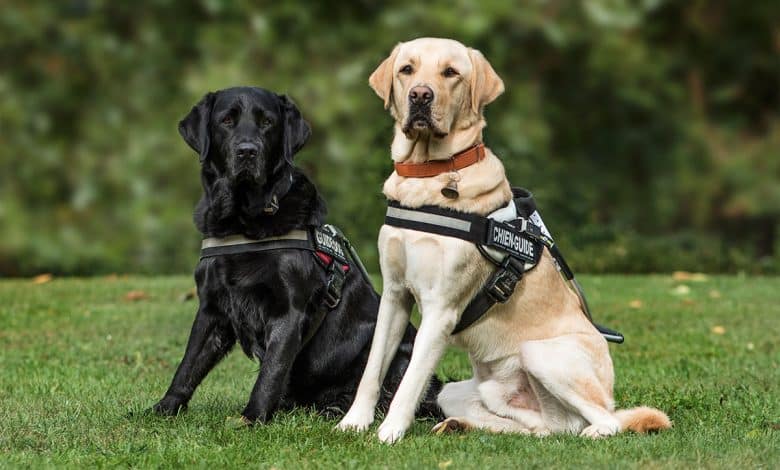
Anyone who is able to treat her as a member of the family and offer her the attention and training she deserves.
Families with older children will be a good home to place the Labrador in. Other great choices include active individuals, or someone looking for a hardworking dog.
They are definitely not for those with sedentary lifestyles, or those who are looking for a guard dog.
Further reading: Labrador Retriever Mixes
- Pitbull Lab Mix
- Lab Hound Mix
- Boxer Lab Mix
- Lab Terrier Mix
- Lab Chow Mix
- Husky Lab Mix
- Labrador Beagle Mix
- Canis Panther
- Australian Shepherd Lab Mix
- Lab Malamute Mix
- Great Dane Lab Mix
- 57+ Labrador Retriever Mixes
Reference
- https://www.whitehousehistory.org/photos/fotoware?id=4223CE23619B4E05%20A387769923767980
- https://www.guinnessworldrecords.com/news/2015/4/earth-day-ten-of-the-best-environmentally-friendly-world-records-377297
- http://news.bbc.co.uk/2/hi/science/nature/4742453.stm
Cess is the Head of Content Writing at K9 Web and a passionate dog care expert with over 5 years of experience in the Pet Industry. With a background in animal science, dog training, and behavior consulting, her hands-on experience and extensive knowledge make her a trusted source for dog owners.
When not writing or leading the K9 Web content team, Cess can be found volunteering at local shelters and participating in dog-related events.
